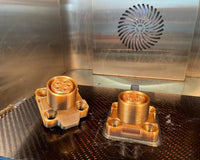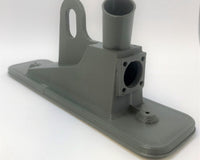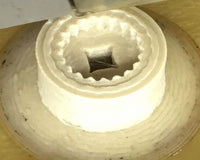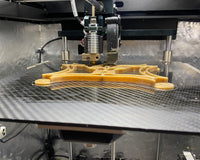A father and son team
3D4Makers was started by father and son team Jan-Peter and Jasper Wille. Jan-Peter had three decades of experience in polymers and Jasper was quickly becoming an expert user of all manner of 3D printers. They had a lot of performance problems with the filament that they bought and used however. Breaking, bubbling, roundness issues and tolerance problems abounded. They also thought that the filament at the time was not only low quality but also far too expensive. The filament that was out there was simply not made at the level of precision that they wanted and caused too many 3D printing problems. They decided to change this by making their own filament, a filament that would have higher strength and printability.
A PLLA test print made on an Ultimaker 3D printer. 3D4Makers PLLA is usually used as a scaffold material for bioprints.
Building an Extruder
They could not find extrusion equipment that would make filament without cooling it with water. It was essential for them to find something that would not use water because this degrades the filament. Standard filament extrusion equipment is water cooled and the filament is dipped into water bath at a set temperature to cool it down as it extrudes.
Most people are aware that moisture degrades the performance of PLA. Some other materials such as PA 6, PA 4/6, PA 12 and PA 66/6 also have these problems. ABS, PC , PET, PEI, PMMA and other engineering plastics suffer from the same issues to varying degrees. Moisture is not only a problem during extrusion however. Moisture also degrades your 3D printing performance. To solve this they invented a completely new extrusion process where the filament does not come into contact with water during cooling.

Ardy Struijk in front of a prototype of the 3D4Makers Filament Extruder.
A simple build
Jan-Peter and Jasper then decided that it would be relatively simple to build an extruder capable of making filament to their exacting standards. They thought it would be a short and easy build project for them. It would consume the next two years of their lives. Servan Bakker, who had 13 years of experience building industrial extruders, joined the team to help them with his unparalleled experience in making nozzles for high volume polymer extrusion for 3D printing. A good friend of another son of the father, Robert Becker then came in to invest in the idea and handle IT and the website to startup. A friend of his, Ardy Struijk then joined to take care of marketing and sales (and everything else that comes up!) for the five person team. After two years of hard work the extruder is now able to make high quality filament with a unique process that uses a multiple jet air cooling system to precisely manage the cooling of the filament without using water. Each of the five team members is a shareholder in the Haarlem based start up. Ardy is “proud of the team and myself for coming this far against all odds” and is also “incredibly excited that so many research institutes are using 3D4Makers filament for emerging research in bioprinting”, “it just blows me away that people are using our PLLA and PCL filaments for things such as scaffolds for biofabrication in making things such as skin and organs. ” Jasper is “very proud that our start up serves dozens of universities and research institutions worldwide with high temperature materials such as PEEK. Since so few companies of any size have managed to make PEEK filament this successfully.”
High Grade Filaments for Engineering and bioprinting


PEEK 3D Printed Parts made with 3D4Makers PEEK.
Having built an extruder gives 3D4Makers material unique capabilities. The 3D4Makers process gives filament better ovality. We found that in layer adhesion of 3D printed parts is improved because of our production process. This means that you will get better and stronger 3D printed parts with 3D4Makers filament as compared to any other filament supplier. The same grade of PLA from the same plastics vendor will print into stronger 3D prints if we turn it into filament. Parts 3D printed with our materials also exhibit higher impact resistance than parts made from other filaments. Due to our unique production process, and extensive polymer knowledge we can also make 100% materials. 100% materials are filaments that 3D print but have no additives in the material. No plasticizers for example. Our materials are also ionised and many have food contact approval and are biocompatible or biodegradable.
Examples of Materials
On standard extrusion lines, extruding many materials would be problematic or not possible. It also means that we can make materials consistently with high tolerances on the diameter and on roundness/ovality. Commercially the team initially struggled to sell high grade materials in direct competition with bulk PLA. Success came through word of mouth from university researchers. Researchers found out and shared information about 3D4Makers engineering materials. By offering a unique PEEK grade with higher printability the team made a real impact for people looking for high performance 3D printed parts. By developing unique materials such as PCL 100, PCL 99 and our PLLA researchers in biofabrication and 3D bioprinting research found the company and started to support it. 3D4Makers now is small but at the very cutting edge of filament production, looking at a bright future in manufacturing using 3D printing.

Materials
PEEK is a high performance material with a wide array of applications. PEEK has high chemical, wear and temperature resistance. We have a unique grade of PEEK for 3D printing with a high degree of printability available in 2.85mm and 1.75mm. Most of our customers for PEEK are research institutions, manufacturers and universities using it for engineering in aerospace and other fields. PEEK requires a Nozzle temperature of above 355 Degrees and an enclosed chamber with good temperature control to print well. Roundness is 99% and we have tolerances of +/- 0,05mm on diameter.
Another high performance material that we have is PEI. An alternative high performance material that we offer is PPSU.

PEI (polythermide) filament for high temperature applications.
We are the first worldwide to develop PCL filament. Our PCL or polycaprolactone filament comes in two grades 99% pure and 100% pure. Our PCL 100 grade is a 100% pure with no additives. PCL prints at 115 - 145°C with a heated platform temperature of around 30 - 45°C (Please note that when using Cura you may have to adjust your Gcode to print below 170). Post 3D printing the model can be heated to 55°C and formed in place.

A PCL tensile strength bar on a UTM courtesy of Nieves Cubo Matteo of UCM CSIC and Exovite.
This makes PCL an ideal strong material for custom braces, custom grips or prosthetics. Most of our customers for this material use it in medical research. The material is non toxic and fully biodegradable.
We also have PLLA filament which is a 100% pure and is mainly used in biofabrication and 3D bioprinting research. One of the most common uses customers have for our PLLA is as a scaffolding material for biofabrication.
Additionally we have ASA which has a high degree of printability and is a tough weather resistant material. Our ASA significantly outperforms ABS and other plastics when 3D printed parts need to be manufactured for tough long term outdoor applications.
You can find an overview of our materials here.







2 comments
Mohammad Jebreel Geraty
Hello,
Do you have any Biocompatible Filament that can be used for surgical Guides any easy to be autoclavable?
Thanks
taha
i asked " tractus3d " about that and connect with you ..
i need to buy 3d printer for peek .. but i need to approved from FDA organization for print body parts and bones , ortho … act
can you finish this approve ?